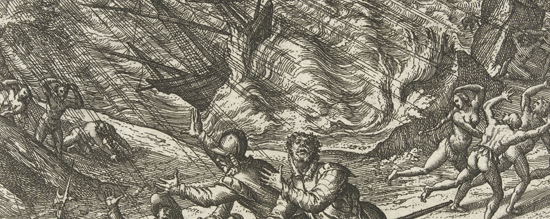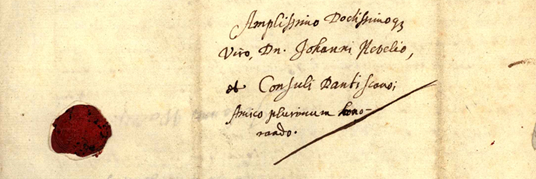* You are viewing Posts Tagged ‘Britain’

Here in the British Isles, summer is living up to its reputation: that is to say, we’re armed with umbrellas, and battling wind, rain, and flood on a daily basis. Indeed, a seasonal dip into EMLO reveals that heavy rainfall from May to September was not such an unusual occurrence.
Seventeenth- and eighteenth-century summers saw floods the length of the Cherwell valley. There were thunderstorms, whirlwinds and panic-stricken haymakers, damaged crops, stormy summer nights, as well as danger and disruption to transport. There were stiff August winds in the Solent and delays with naval manoeuvres on account of storms in the Channel. The summer of 1682 seems to have been especially wet. Magistrate Edmund Warcup laments the effects of rain on his corn and grass, of floods on his fields and livestock – the poor chap lives in fear of cattle rot – and is forced to take action against the deluge. On 9 May of this same year, clergyman William Jenkyn wrote to Philip Wharton to warn him that ‘the floods are out so bad between Uxbridge & London that it is very dangerous to travel so advises his Lordship to postpone his journey’.
Thus, although all was not gloom and doom during these seasonal soaks (James Long informs John Aubrey that lamprey eels are ‘plentiful in flood time’), it’s small wonder that the time-honoured cliché of sodden summers came into being. As we forego sandals and shorts for galoshes and gumboots, it’s worth reflecting that our ancestors may have been thankful for cold, wet summers as, with the heat in cities, came plague (more on that in a future post), and fine weather was not a cure for all ills. On 6 June 1677 Robert Digby wrote to Thomas Smith that he hoped to see him at the next sitting of Parliament ‘if I can get rid of my cough which wears away, God be thanked, very much this kind weather’, yet favourable temperatures did not work magic in this case; the poor young man was dead by the end of the year.
Miranda is editing metadata from the Bodleian card catalogue of correspondence for our union catalogue, Early Modern Letters Online. On a regular basis, she brings us hand-picked and contextualised records.
 With its whirl of bunting, teapots, cotton frocks, and the river pageant, Diamond Jubilee fever is sweeping the country for just the second time in British history. Early modern subjects might not have had the opportunity to celebrate a sixty-year reign, but it’s clear from Early Modern Letters Online – itself replete with royalty from across Europe – that they knew how to mark in style royal and aristocratic betrothals, marriages, and birthdays, whilst countrywide celebrations of military victories and triumphant peace treaties helped bolster national unity.
With its whirl of bunting, teapots, cotton frocks, and the river pageant, Diamond Jubilee fever is sweeping the country for just the second time in British history. Early modern subjects might not have had the opportunity to celebrate a sixty-year reign, but it’s clear from Early Modern Letters Online – itself replete with royalty from across Europe – that they knew how to mark in style royal and aristocratic betrothals, marriages, and birthdays, whilst countrywide celebrations of military victories and triumphant peace treaties helped bolster national unity.
Then, as now, cities, towns, and institutions arranged peals of bells, official gun salutes, and lavishly styled river pageants for their inhabitants to enjoy. Eminent speakers delivered orations and sermons from pulpits at moments of national importance – we read how ‘Dr. Sherlock is to preach in St. Pauls before Q.Anne to celebrate the glorys and triumphs of the late victorys in Germany. “You may easily imagine that the D. of M. will have no inconsiderable part in the panegyrie”’. Professional intelligencer John Pory wrote to Sir Robert Cotton in 1607 describing the masque Hymenaei which was designed by Inigo Jones and written by Ben Jonson to celebrate the marriage of Robert Devereux, Earl of Essex, and Lady Francis Howard (not that of Prince Henry, as erroneously noted in the abstract). Just as we do today, they enjoyed firework spectaculars; and at the end of the War of the Spanish Succession we find ‘an invitation to the freeholders of Canterbury to partake of a roast ox, bread and beer to celebrate Peace on July 8’ (a service in St Paul’s Cathedral was held also to mark the Peace of Utrecht, at which Handel’s Utrecht Te Deum and Jubilate was given its premiere). As one might expect, bonfires and beacons lit the night sky on numerous occasions and finery was donned for balls and dances, but, in a week during which the highlight here at Cultures of Knowledge has been a paper on the correspondence of James I’s daughter Elizabeth Stuart (podcast to come!), the ‘Winter Queen’ reminds us what’s missing today: scheduled into the festivities that marked her marriage to Frederick, Elector Palatine is the description of a ritual we have lost in these modern celebrations – the tilting match, or joust. Something to suggest to cyclists at the local street party?
Miranda is editing metadata from the Bodleian card catalogue of correspondence for our union catalogue, Early Modern Letters Online. On a regular basis, she brings us hand-picked and contextualised records.
 A recent correspondence-related public lecture by our Martin Lister Research Fellow Dr Anna Marie Roos has now been published as a podcast. The lecture, which took place at Oxford’s Museum of the History of Science on Tuesday 26 October, was entitled ‘The Oxford Philosophical Society and the Royal Society: A Meeting of Minds?’, and described the formation of the Oxford group, the work done under the direction of Robert Plot, and its relationship with the Royal Society: a tale of collaboration as well as rivalry. The podcast is available for listening and downloading on the MHS website.
A recent correspondence-related public lecture by our Martin Lister Research Fellow Dr Anna Marie Roos has now been published as a podcast. The lecture, which took place at Oxford’s Museum of the History of Science on Tuesday 26 October, was entitled ‘The Oxford Philosophical Society and the Royal Society: A Meeting of Minds?’, and described the formation of the Oxford group, the work done under the direction of Robert Plot, and its relationship with the Royal Society: a tale of collaboration as well as rivalry. The podcast is available for listening and downloading on the MHS website.
James Brown
June 03, 2010
Events, Lectures, Project Updates
Tags: Amerigo Salvetti, Britain, Diplomatic History, English Civil War, Italy, Politics, Protectorate, Seventeenth Century, Tuscany
In the fifth installment of the Project’s seminar series on Thursday 27 May, Professor Stefano Villani (University of Pisa) introduced us to ‘Tuscan Readings of the English Revolution: The Correspondence of Amerigo Salvetti and Giovanni Salvetti Antelminelli’. Villani focused on the communications sent by the elder Salvetti, a Tuscan informer and diplomat based in London, to the Grand Duke of Tuscany between 1649 and 1660, during which the former dispatched both a newsletter and a personal letter on a weekly basis updating the Tuscan court on developments within the new English Republic. Villani argued that within an environment in which Italian responses to the Protectorate regime were both highly regionalized and lacking in ideological consistency, the letters reveal Tuscans to have had more interest in and sympathy for the Cromwellian administration than either Venetians (who regarded it as a military dictatorship orchestrated by a religious fanatic) or Genoans (who viewed it ambivalently as a kind of protracted Machievellian experiment). As well as describing this ‘Anglo/Tuscan moment’, Villani sketched some fascinating differences between the two styles of missive – newsletter and personal letter – both of which took over a month to reach their recipients on the peninsula. The newsletters, which are anonymous and unsigned, provide a ‘pragmatic’ third person narrative of political events free of subjective judgements and commentaries (and often enclosing translations of English documents). The personal letters, by contrast, are written in the first person, sometimes in cipher, and signed, and contain many idiosyncratic political insights as well as numerous personal references. Seminars take place in the Faculty of History on George Street on Thursdays at 3pm. For future seminars in the series, please see here.
 Podcast now available on the seminar page!
Podcast now available on the seminar page!

Detail of letter from John Wallis to Jan Hevelius. Oxford, 26 October 1668 (Waller Collection, Uppsala Universitet, Uppsala; Waller MS gb-01783).
In the fourth installment of the Project’s seminar series on Thursday 20 May, Professor Henry Woudhusyen (University College London) examined the material dimensions of epistolary practice in a fascinating paper entitled ‘Writing a Letter in Early Modern England: Forms and Formats’. Arguing that the ‘social life’ (or ‘cultural biography’) of the letter-as-object has attracted little sustained scholarly attention (a trend reinforced by the tendency of online repositories of letters to efface their material attributes), Woudhuysen used a wide range of examples to explore varieties of and markets for paper and ink; handwriting, superscriptions and addresses, salutations, signatures, and ‘significant space’ (those portions of the page left deliberately black for symbolic or practical reasons); the complex relationship between the formatting of letters and economics, in particular in terms of the strategies employed by letter-writers to maximise available space in order to reduce the cost of postage (such as cross-hatching and the forced invasion of margins); and different styles of folding and sealing, and their associated connotations. Woudhusyen’s contribution was further enriched by a commentary from Dr Peter Beal (School of Advanced Study), formerly of Sotheby’s, and the creator of the Catalogue of English Literary Manuscripts (CELM). In a wide-ranging addendum, Beal discussed (inter alia) the cultural transmission of epistolary styles, casting doubt in particular on the ability of prescriptive letter-writing manuals to shed light on these complex processes; considered the relationship between the formatting of letters and that of the other products of early modern scribal culture (such as petitions); and explored the ways in which letters were stored and filed by their recipients. Seminars take place in the Faculty of History on George Street on Thursdays at 3pm. For future seminars in the series, please see here.
 Podcast now available on the seminar page!
Podcast now available on the seminar page!
 Papers are sought for a major conference on ‘Cultures of Correspondence in Early Modern Britain, 1550-1640’, which will take place at the University of Plymouth on 14-16 April 2011. According to the organizers, the conference aims to ‘enhance our understanding of epistolary culture and to challenge accepted models of epistolarity through the study of letter-writing practices in all their nuanced complexity, ranging from the textual production of letters, their subsequent delivery and circulation, to the various ways in which letters were read and preserved for posterity’. Abstracts should focus on one the following key themes:
Papers are sought for a major conference on ‘Cultures of Correspondence in Early Modern Britain, 1550-1640’, which will take place at the University of Plymouth on 14-16 April 2011. According to the organizers, the conference aims to ‘enhance our understanding of epistolary culture and to challenge accepted models of epistolarity through the study of letter-writing practices in all their nuanced complexity, ranging from the textual production of letters, their subsequent delivery and circulation, to the various ways in which letters were read and preserved for posterity’. Abstracts should focus on one the following key themes:
- The materiality of the letter: the physicality of correspondence (paper, ink, seals, folding) as well as the social context of epistolarity (composition, delivery, reading, archiving);
- Correspondence networks, the circulation of letters, postal systems, and modes of delivery;
- Letters, news, and intelligence;
- Authenticity, deception, and surveillance: forgeries, secrecy, ciphers, and codes;
- Women’s letters and the gendered nature of letter-writing;
- Epistolary literacies, social hierarchies, and the acquisition and diffusion of letter-writing skills;
- Manuscript letters and letters in print;
- The letter as a cultural genre and the rhetorics of letter-writing;
- Humanistic letter-writing practices and the familiar letter; letter-writing manuals and models; education, pedagogy and learning to write letters;
- Categories or types of letters: suitors’ letters, letters of petition, love letters, letters of condolence;
- Genres of printed letters: prefatory letters, dedicatory letters, address to the readers;
- Staging the letter: letters and letter-writing in drama;
- Editing and the digitization of correspondence.
Proposals of 300 words (including titles) should be sent to James Daybell (james.daybell(at)plymouth.ac.uk) and Andrew Gordon (a.gordon(at)abdn.ac.uk) by 1 July 2010. For further details, please see the full call.

Letters in Focus with Miranda Lewis

 With its whirl of bunting, teapots, cotton frocks, and the river pageant, Diamond Jubilee fever is sweeping the country for just the second time in British history. Early modern subjects might not have had the opportunity to celebrate a sixty-year reign, but it’s clear from
With its whirl of bunting, teapots, cotton frocks, and the river pageant, Diamond Jubilee fever is sweeping the country for just the second time in British history. Early modern subjects might not have had the opportunity to celebrate a sixty-year reign, but it’s clear from  A recent correspondence-related public lecture by our
A recent correspondence-related public lecture by our 
 Papers are sought for a major conference on ‘Cultures of Correspondence in Early Modern Britain, 1550-1640’, which will take place at the
Papers are sought for a major conference on ‘Cultures of Correspondence in Early Modern Britain, 1550-1640’, which will take place at the 
 Join
Join 